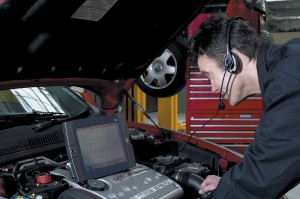
Shop around so you'll be smiling too.
As new car sales languish, dealers are increasing the promotion of repair and collision services to make up for the lost revenue. If you aren’t careful, you could end up paying too much for their services. A new study from the Automotive Aftermarket Industry Association says that consumers paid $11.7 billion too much last year for parts and service.
To arrive at this conclusion AAIA compared the parts and labor costs of 10 vehicle repair jobs for domestic and import brand vehicles in six cities, including Boston, Newark, Atlanta, St. Louis, Los Angeles and Seattle. The study revealed what AIAI called “dramatic differences” in the costs of parts and labor between domestic and import brands, and from city to city. For example, car owners in Los Angeles and Atlanta pay as much as 47% more at dealerships than independent repair shops for repairs; Boston and Seattle repairs at dealerships were only 20% higher.
“In response to repeated requests by congressional leaders studying the merits of the Motor Vehicle Owners’ Right to Repair legislation, AAIA commissioned a study to once and for all provide a comprehensive analysis that validated the contention that it costs consumers more to repair their vehicle at new car dealerships than at independent repair shops,” says Kathleen Schmatz, AAIA president and CEO. AAIA represents more than 100,000 repair shops, parts stores and distributors.

Electronic diagnostic tools are expensive and specialized, a cost passed on to you.
As electronics and onboard computers have completely taken over the monitoring and control of critical areas of a vehicle — brakes, tire pressure, steering, air bags, fuel delivery, ignition, oil change intervals, theft prevention, emission controls — car owners are being forced to return to dealerships since independent shops do not have inexpensive access to necessary diagnostic equipment, troubleshooting codes and specialized tools.
A survey by AAA, a non-profit automobile club with more than 50 million members shows that about 10% consumers were unhappy with their most recent visit to a repair facility. The biggest complaints are the inability to fix problems on the first visit or to diagnose problems properly.
The Motor Vehicle Owners Right to Repair Act that AAIA is pushing prevents vehicle manufacturers from “unfairly restricting access to the information and tools” necessary to accurately diagnose, repair, re-program computers or install automotive replacement parts. At issue is your right to shop around for repair services and where you can go to have repairs performed.
Dealerships used to thrive on carmaker-paid warranty repairs, but that business has all but evaporated as quality has relentlessly and dramatically improved from all automakers during the past decade. So a battle royal is on for your repair dollars. It’s worth fighting for; the aftermarket is a huge part of the U.S. economy, about $295 billion in products and services, employing about 4.5 million people, according to AAIA.
The Right to Repair Act would require the Federal Trade Commission to promulgate and enforce regulations that ensure competition in the repair business. In addition, it would permit the FTC, car owners and independent repair facilities to take legal action to get information and tools at affordable prices.
Various forms of the act have been tied up in three successive Congresses since 2002. It has not yet been reintroduced in the current 111th session. It is not surprising that the National Association of Automobile Dealers opposes the legislation. It points out that automakers provide emissions-service and some other data available to any technician who needs it, a response to earlier versions of the bill.
The National Automotive Service Task Force(NASTF), serves as a portal to the automaker repair-data sites, and repair shops may pay makers a onetime fee for short-term access to the information, ~$10-$115, or a larger fee for longer-term access, ~350-$7,000. Of note, Kia and Hyundai do not charge technicians for the information, perhaps a contributing factor in their high customer satisfaction rates.
In the AAIA survey the disparity in costs was higher for import brands than domestic ones. Repairs performed at import dealers averaged 37% more than at independent repair shops, while repairs performed on domestic nameplates averaged 32% more at dealerships than at independents.
While the general trend information appears accurate to TDB, exact percentages might not be; 840 telephone interviews were conducted with people at new car dealerships and independent repair shops to compile the data.
As always it pays to shop around, since the cost of individual repairs varies widely. A radiator repair — parts and labor — for an import brand was 87% higher or $665.28 at dealer compared to $311 at an independent. At the other end of the scale is a 15% difference for an air conditioning compressor — $933 dealer, $812 independent. This might reflect the fact that an independent might have to buy factory parts, as the dealer is required to do, if an aftermarket version isn’t available. The quality of aftermarket parts can also vary widely.
“Many disputes between consumers and repair shops are the result of misunderstandings over what was supposed to be repaired and what was actually done,” says John Nielsen, director, AAA Approved Auto Repair Network. AAA has supported previous versions of the Right to Repair Act.
While Congress dithers, AAA has some helpful tips about repair work:
- Determine what type of repair facility is needed. Most vehicles can be repaired and maintained by a full-service repair facility, but if there is a major problem with a specific vehicle system, a shop specializing in that area might be the best choice. Vehicles still under warranty typically must be repaired by the dealer.
- Select a repair facility you trust. Friends, relatives and co-workers are a good source of recommendations.
- Make an appointment. If the manager knows a motorist is coming and has a rough idea of the problem, the right technician can be assigned to the job.
- Describe the problem. Don’t tell the technician what needs to be repaired or replaced unless it’s obvious. Instead, describe the problem and its symptoms, and let the technician determine the appropriate solution.
- Read the repair order. Be wary of blanket statements such as “check and correct transmission noise” or “fix engine;” Never sign a blank repair order or tell the shop to “just fix it” or “do what’s necessary” unless the problem is covered under warranty.
- Get a written estimate.
Consumers can also look for one of the more than 8,000 AAA Approved Auto Repair facilities in the U.S. and Canada. AAA regularly surveys shops’ repair customers to ensure ongoing high customer satisfaction. Click here to locate AAA-approved shops.
The independent, non-profit National Institute for Automotive Service Excellence (ASE) is another good source for finding qualified technicians and shops. About 400,000 professionals hold current certifications. They work in every segment of the automotive service industry: car and truck dealerships, independent garages, fleets, service stations, new vehicle franchises. Click here to find an ASE shop.

To promote or foster a “Right to Repair Act” is just another effort “equalize” every aspect of American Society. There is no such thing a “right to repair.” The economic free market dictates the prices associated with any type of service or repair.
Franchised automobile dealers pay huge sums of money to train their staffs, purchase special equipment and tools, and advertise their services to the general public. Many of the new parts and technology are proprietary. If the independent shops want to have access to this market, let them invest in the training, tools, equipment and promotion that the dealer body has.